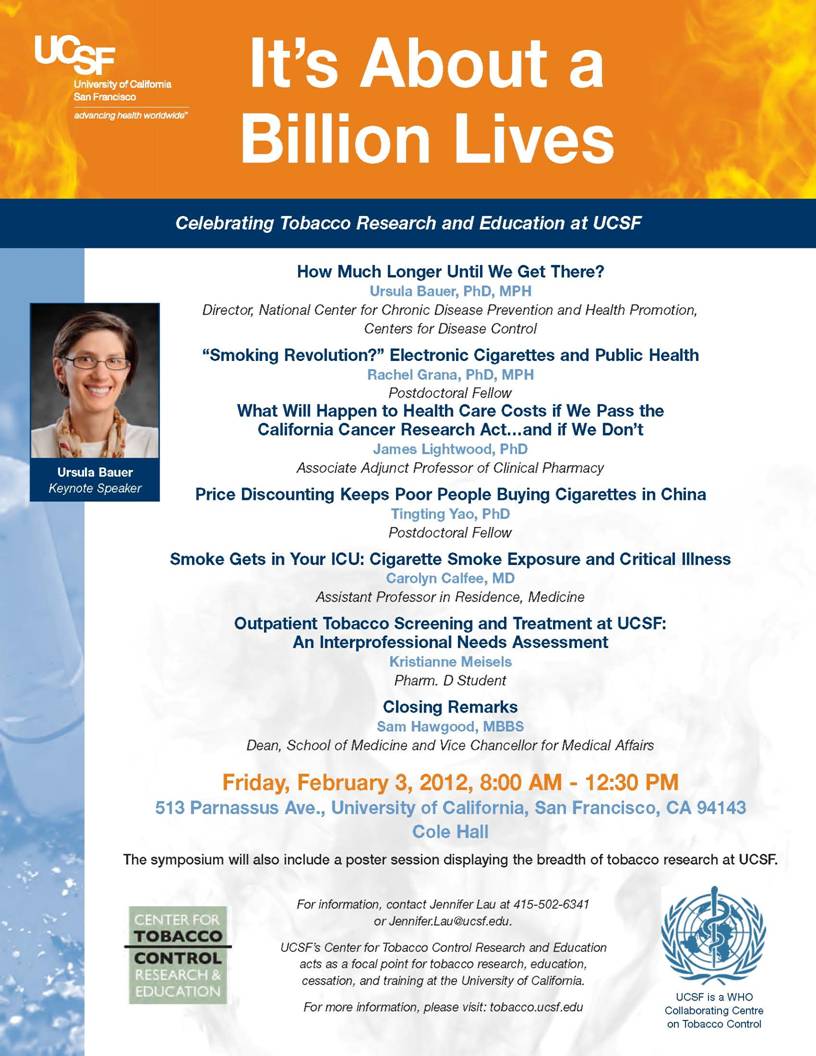February 6, 2012
A new UCSF analysis has found that a state ballot initiative to increase the cigarette tax would create about 12,000 jobs and nearly $2 billion in new economic activity in California.
The study found that the new tax would have a significant effect on the state’s overall economy because Californians would smoke less and spend their money in other ways.
The initiative, the California Cancer Research Act (CCRA), is on the statewide June 5 ballot. If the measure is approved, state cigarette taxes would rise by $1 a pack, generating an estimated $855 million a year for anti-smoking education programs, medical research, and tobacco law enforcement.
“The primary impact to the California economy, besides the effect on health care, is that people will smoke less and send less money out of state,’’ said study author Stanton A. Glantz, PhD, a professor of medicine at UCSF and director of the Center for Tobacco Control Research and Education based at UCSF.
Currently, approximately 80 percent of money spent on tobacco products is exported to out-of-state tobacco manufacturers and farmers. No tobacco is grown in California and no cigarettes are manufactured here.
February 5, 2012
On September 20, 2007, after a multi-year debate the UC Regents adopted a compromise policy on acceptance of money for research from the tobacco industry. While then-President Robert Dynes, with the support of the Academic Senate, defeated the proposal by then-Chairman of the Board of Regents Richard Blum to establish a policy of not accepting tobacco industry funding, the Regents did adopt a policy (known as RE-89) that recognized that money from the tobacco industry was problematic and required that any new proposals to the tobacco industry undergo additional internal peer review and that the campus chancellor personally approve any such proposal. It also required that the President make an annual report to the Regents on any new tobacco industry grants.
According to UC President Yudof's most recent report, since then there has not been a single new tobacco industry grant within the entire University of California.
There are only two remaining grants (that date from before RE-89), totaling $2.9 million, both from Philip Morris USA:
February 5, 2012
January 30, 2012
Five US Senators -- Frank Lautenberg, Dick Durbin, Tom Harkin, Sherrod Brown, and Richard Blumenthal -- have written a letter to the FDA Commissioner urging the FDA to get the lead out and start effectively protecting consumers.
Among other things, the senators pointed out that, "cigarette companies continue to deceptively market their products, misleading consumers about the health consequences that come from smoking. For example, American Spirit Cigarettes, made by Reynolds American subsidiary the Sante Fe Natural Tobacco Company, claim to be 'natural' and 'organic,' implying that these cigarettes are better for smokers' health. Likewise, Philip Morris Company sells Marlboro Smooths as well as Virgina Slims, whose names have similar 'healthy' connotations. Additionally, companies use colors to suggest that some cigarettes are safer. Marlboro now uses Gold and Silver as code for 'light' and 'ultra light.'"
These concerns mirror increasing frustration I am hearing broadly across the health community.
January 14, 2012
UC President Mark Yudof has written the chancellors of all 10 UC campuses instructing them to develop and implement smokefree policies by 2014. (UCSF is already smokefree, including e-cigarettes).
The policy includes all tobacco products (including smokeless and e-cigs) and indoor and outdoor spaces. It also prohibits the sale and advertising of tobacco products. It applies to all UC facilities, including housing, which may make this the largest single expansion of smokefree multiunit housing.
This decision was announced in response to recommendation from the systemwide Smoking Policy Subcommittee of the Occupational Wellness Forum; its report is an excellent resource for people considering similar policies elsewhere.
UCSF is already smokefree.
There is a good story on this in the San Francisco Chronicle.

